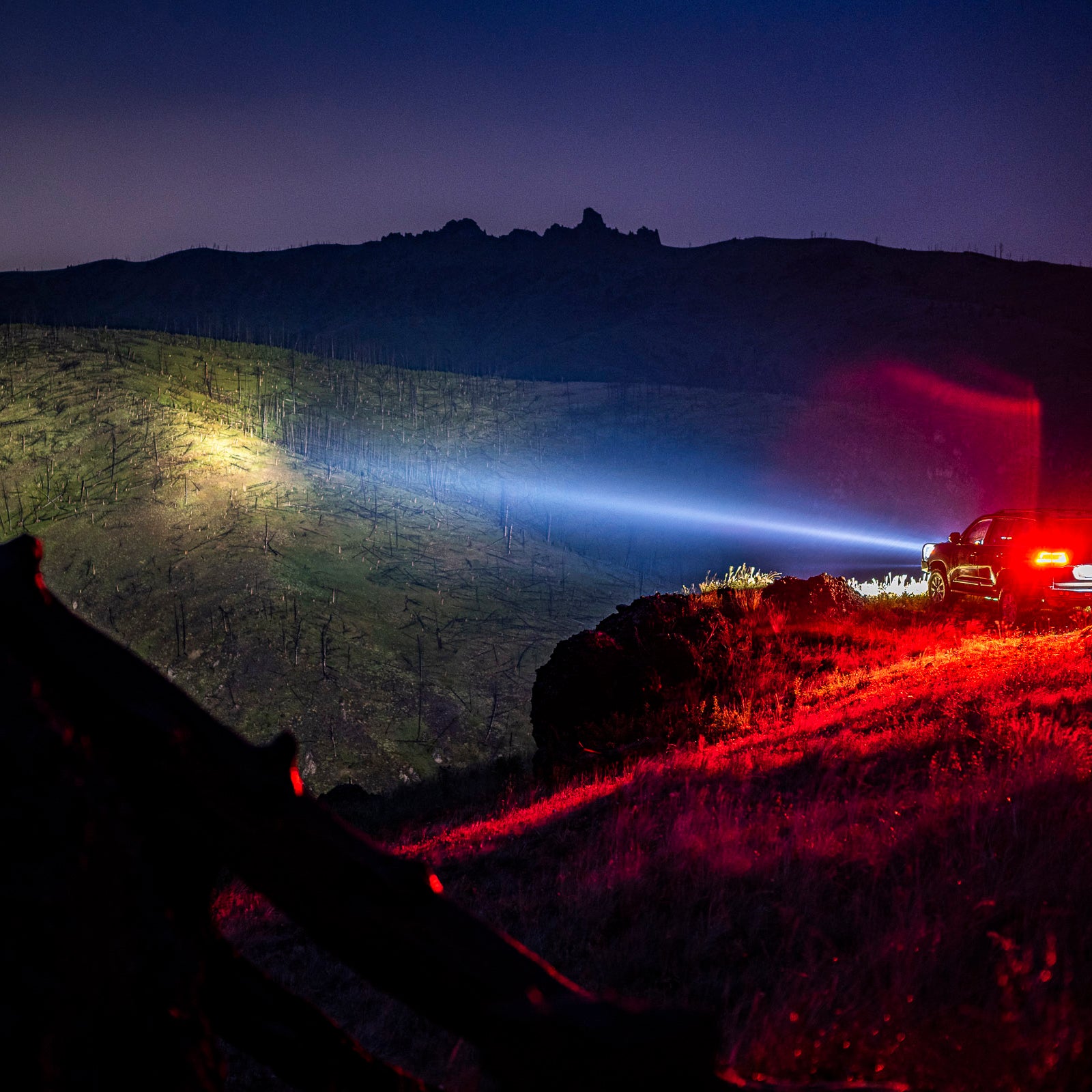Your car or truckÔÇÖs stock headlights may be adequate on paved roads╠řat moderate speeds, especially when paired with streetlights. But throw in the utter darkness in the middle of nowhere, or even just a little weather, and youÔÇÖll find them sorely lacking. What can you do about that? Fit your vehicle with aftermarket driving lights.
ArenÔÇÖt Those Things Illegal?
Regulations vary by state, but running non-DOT-approved lights on both paved and dirt roads is illegal everywhere in the United States. In some states, simply driving around with them uncovered, even if theyÔÇÖre not switched on, is against the law, too, so be sure to check your own stateÔÇÖs regulations. However, aftermarket driving╠řlights, regardless of their certifications, are legal on off-road trails╠řand in other countries like Australia, where the transportation mix leans more rural. If╠řyou do outfit your car with them, switch them on when you need them, and be careful to turn them off any time youÔÇÖre near other drivers.
ÔÇťCar shoppers need to think about headlights as a safety feature in the same way they think about brakes or even seat belts,ÔÇŁ stated Jennifer Stockburger, director of operations at╠řConsumer ReportsÔÇÖ╠řvehicle test center, in a╠ř that the publication ran last year. So why not make those lights better?
(Andrew Collins,╠řover at the car website Jalopnik,╠řput together ╠řof why LED bulb upgrades for your standard headlamps donÔÇÖt work.)
After appropriate tires, driving lights may prove to be the most effective safety aid you can add:╠řbeing able to see farther down the road increases the amount of time you have to react to obstacles. ThatÔÇÖs especially important in slippery conditions, where braking distances increase. Slippery conditions are caused by precipitation, which some driving lights may also help you see through.
I think driving lights are so helpful that they were among the first modifications I made on╠řall three of the trucks my wife and I drive. And because anything worth doing is worth doing right, I went to great lengths to ensure each of those trucks is fitted with the best possible solution for its individual use case. HereÔÇÖs everything I learned in the process.
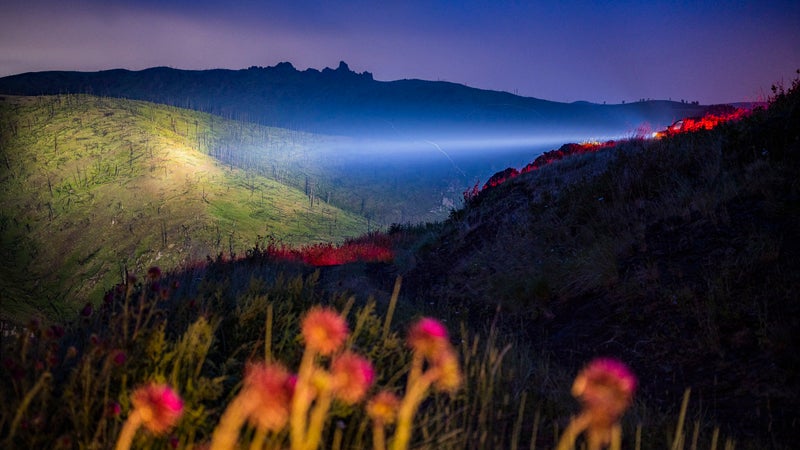
Outright Power Is Meaningless
A typical 18-wheeler has about 600 horsepower. A Tesla Model 3 has 258 horsepower. Which one is faster?
In the same way that horsepower alone cannot determine a vehicleÔÇÖs performance, the stated power of a driving light is meaningless without context.╠řIn the past, the power of a driving light was stated in watts. This is a fairly useless way of looking at light performance, because itÔÇÖs only a measure of the power used. With the advent of the first high-intensity-discharge (HID) bulbs╠řand then light-emitting diodes (LED), lighting technology became drastically more efficient than the halogen bulbs of yore.╠řA light made using one of those technologies will produce far more power than a halogen headlamp with equivalent draw. So╠řlight makers began quoting power in lumens.
A lumen is a standard unit of brightness,╠řthe amount of brightness a light produces in all directions. Because itÔÇÖs an output number, itÔÇÖs loosely equivalent to that horsepower comparison weÔÇÖre using. But raw lumens are in another wayÔÇötheyÔÇÖre a calculation, not a measurement.
The makers of driving lights donÔÇÖt manufacture bulbs or LEDs themselves, they buy them from a handful of suppliers, then assemble them into the driving lights you buy using reflectors, lenses, circuit boards, mounts, and other parts. Those bulb or LED manufacturers supply the light makers with performance figures, and itÔÇÖs common to see those figures simply passed along to the consumer. If a lighting brand assembles a driving light equipped with ten╠řLEDs that the╠řmaker claims are capable of up to 1,000 lumens each, then thatÔÇÖs a 10,000-lumen driving light, right? Not so fast.
If you ever see light output quoted in ÔÇťrawÔÇŁ╠řlumens, you should understand that number to be entirely fictional. Even if a lightbulb or LED is theoretically capable of producing 1,000 lumens in ideal lab conditions, its power will typically be reduced 10 to 25 percent when installed in a light due to losses from heat, reflections off the inside of the lens, or simply quality variances.
A more realistic determination of light output is effective lumens, which is actually a measurement taken 3.3 feet╠řin front of the light. Even in a best-case scenario, that 1,000-raw-lumens LED is really only going to be capable of producing 750 to 900 effective lumens. And there are an awful lot of driving lights out there that are very far from being a best-case scenario.
Plus, measuring only the outright amount of lumens a light puts out remains an unrealistic way to express the performance of that lightÔÇömostly because youÔÇÖre not using a driving light to illuminate something sitting 3.3 feet╠řin front of it. YouÔÇÖre using a driving light to try and see stuff farther down the road or trail than your stock headlights reach. So╠řto determine the effectiveness of a driving light, you need to know how much of its light reaches a certain distance. Enter lux, which is a measurement of the intensity of light.
YouÔÇÖll typically find lux expressed as the distance at which a light can project╠řone of them. One lux is equivalent to one lumen per 10.8 square feet. Think of that as the minimum amount of light it takes to comfortably read normal book-size╠řtext. Because thatÔÇÖs an amount of light╠řitÔÇÖs easy to envision,╠řthis measurement makes it simple to understand the performance of a given light source╠řor to compare them. If one driving light is capable of producing one lux at 600 yards, and another can do the same at 800 yards, we can all understand that the latter is the more powerful driving light and╠řwill enable us to see farther down the road.
Because lux must be expensively tested in the real world, rather than simply quoted from lab results, IÔÇÖve noticed that only higher-end light manufacturers tend to report this number. The best of those submit their lights to an independent third-party tester╠řto give their customers total transparency.
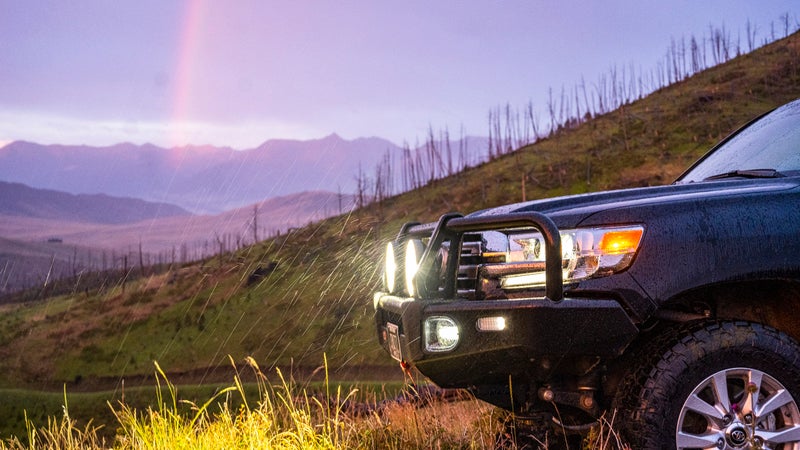
LEDs Versus╠řHIDs
YouÔÇÖll note that a lot of the talk above centers around the performance of LEDs. ThatÔÇÖs because the technology is so trendy right now that it dominates the driving-light space. And thatÔÇÖs a shame, because while there are╠řthings LEDs can do that HIDs cannot, both remain very relevant to todayÔÇÖs drivers.
ÔÇťYes, theyÔÇÖre stylish, but drivers need lights that will make them safer╠řand not just make a fashion statement,ÔÇŁ explains╠řConsumer ReportsÔÇÖ Stockburger, who says╠řthat the small size and low power draw of LEDs are╠řallowing designers to package them into new shapes and spaces and that light makers are embracing them for one important reason beyond style, too: theyÔÇÖre cheap.
A light-emitting diode is a small semiconductor that emits light when electrical current passes through it. Because itÔÇÖs entirely electric,╠řit reaches full intensity the moment itÔÇÖs powered on. Inside an HID bulb, pressurized xenon gas is excited by the current passing between two electrodes. Because it takes a couple of seconds for that gas to heat up, HIDs, especially very powerful ones, take a couple of seconds to reach full intensity. Hit the switch for an LED light and it will light up instantaneously; in contrast, HIDs grow in brightness for several seconds after being turned on.
The life span of an LED is typically 50,000 hours. The life span of an HID bulb is around 9,000 hours. The former will easily outlast any vehicle itÔÇÖs mounted to. The latter is equivalent to roughly 90,000 miles of use. But since you likely donÔÇÖt drive exclusively at night, or exclusively on remote tracks with no other drivers, HID╠řbulbs will likely outlast your vehicle, too. And while LEDs may have a longer life span, if╠řan LED in a driving light fails, youÔÇÖll probably need to replace the entire light. If an HID bulb burns out, you can simply replace the bulb.
LEDs are small, and it takes several to many of them to produce a powerful driving light. That makes it challenging to design and produce lenses and reflectors for each LED that are capable of gathering and throwing light over a long distance. HIDs are so powerful that it only takes one to make an effective driving light, meaning that only a single lens and reflector is needed. This is easier and cheaper for the light maker, allowing many brands to sell lights capable of reaching an extraordinary distance at a reasonable price.
ItÔÇÖs a common misconception that LEDs donÔÇÖt produce heat. More accurately, LEDs donÔÇÖt produce infrared radiation;╠řthey donÔÇÖt project heat from the light source like incandescent bulbs do. But ,╠řsometimes converting as much as 85 percent of input energy into heat and just 15 percent into visible light. Managing this heat is a major challenge for designers of driving lights, and itÔÇÖs why theyÔÇÖre typically housed in cast-aluminum heat sinks. In contrast, HIDs do produce infrared radiation (heat) in addition to visible light. The lens of an HID driving light will feel warm, but its housing will feel cool.
These factors add╠řup to some different packaging requirements for HIDs and LEDs. HID bulbs are a couple inches long╠řand must be fitted with a ballast (which temporarily boosts input power when the light is turned on╠řto arc electricity between the electrodes)╠řand housed in a reflector to work properly. An HID driving light will typically melt airborne snow and ice before it can accumulate on the lens. While high-power LEDs require heat sinks, low-power ones do not. And╠řif projecting their light over distance is not a concern, neither do they require any sort of reflector or lens, just a protective housing. So╠řlower-power LEDs can be packaged into very small lights. Airborne snow and ice can accumulate on the lenses of LED driving lights.
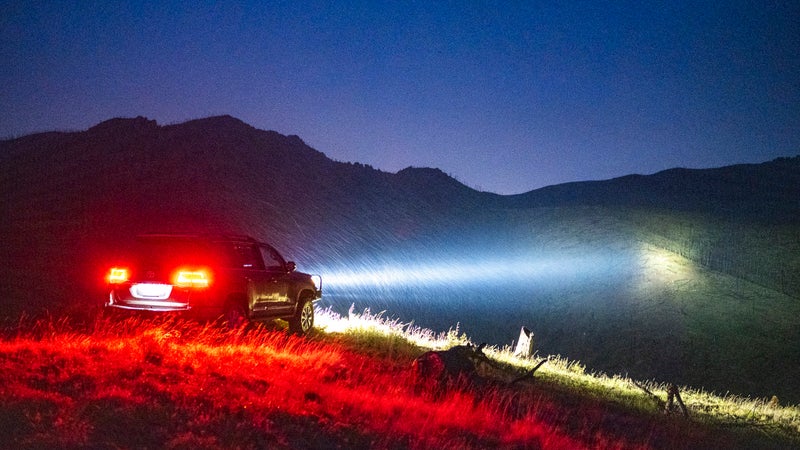
Color Temperature
The color of light is expressed as a temperature, ranging from warm to cool. Warm lightÔÇöred to yellowÔÇöpenetrates dust, fog, and precipitation with minimal reflection, thanks to its long wavelengths, but it can impair the ability of our eyes to discern color. Cool lightÔÇöblue to violetÔÇöcan appear very bright, but it produces glare and reflections due to its short wavelengths╠řand can cause eye strain. What you want is something as close to natural daylight as possible, which will be easiest on our eyes, provide ample illumination, good contrast, and accurate color rendering. While itÔÇÖs common to see both HID and LED lights lean toward╠řthe cool side of the spectrum, thatÔÇÖs just because most light makers donÔÇÖt take the time to dial in accurate color rendering.
The color temperature of daylight varies with conditions╠řbut . Driving lights operating in this temperature range will not appear yellow or blue in color╠řbut rather a nice, even white. Driving with lights that operate in this range (or slightly warmer)╠řwill maximize vision, contrast, and depth perception, all while reducing eye fatigue.
Lighting Zones
Outright straight-line distance in front of your vehicle probably isnÔÇÖt the only area you want your driving lights to illuminate. Depending on the terrain youÔÇÖre driving through, and the weather conditions, it may be optimal to light up an area closer to the front of your vehicle, more to its sides, or, if youÔÇÖre really working hard off-road or just camping, maybe to the rear╠řas well.
By helping you see into the distance, which maximizes╠řyour reaction time, spotlights are most helpful at higher speeds. Illuminating a mile out╠řreally enables you to relax on long nighttime drives, rather than straining your eyes to make out the presence of animals, ditches, or other obstacles at the last second. But╠řhigh-power spotlights can also overwhelm you at lower speeds, particularly in technical terrain, which may reflect╠řlight back to you at close distance.
Floodlights illuminate╠řa broader area╠řout to a shorter distanceÔÇötypically a couple hundred yards. In doing so, they can help you see potential hazards╠řoff to the side of the road or trail╠řand help light up╠řturns and corners. You donÔÇÖt want floodlights to be too terribly bright, since theyÔÇÖre designed to work at distances╠řcloser to your eyes. Floodlights may be packaged into an all-round lighting solution, like a light bar, or may come designed for a specific zone, like a fog light. By upgrading the power of fog lights, running them in a warm color temperature, and angling them down and out to the sides, you can maximize their ability to provide vision through fog or dust. Some people also mount small floodlights on the sides of their trucks, pointing perpendicularly to the direction of travel. These may help you navigate very challenging terrain╠řor just illuminate the entire area surrounding the truck when you come to a stop.
Work lights are designed to give you good vision inside the bed of a pickup╠řor to the rear of any vehicle. They donÔÇÖt help with driving, but rather make effecting roadside repairs or setting up camp as easy as possible.
A vehicle can be fitted with any or all of the above. Switched╠řseparately, different lighting solutions illuminating different zones can help you respond to changing driving╠řconditions, variable weather, or just the variety of tasks your vehicle may help you perform.
My Solutions
My wife and I have three trucks, all designed for different tasks. The lights fitted to each reflect their specific use cases.
The first is our 1998 Toyota 4Runner╠ř(above), which I built for us to use when MontanaÔÇÖs winter weather gets particularly bad╠řand the likelihood of damaging a vehicle is high. ItÔÇÖs also the car╠řwe loan to houseguests; one of them drove it to Salt Lake City and back over the╠řweekend.
The 4Runner is fitted with a pair of six-inch .╠řWith a pair of round lights, itÔÇÖs typical to fit one designed for flood╠řand one designed for spot, in order to add the benefits of both to your vehicle. But╠řbecause the old 4Runner is mostly used to drive around our local area, typically in snow or off-road, and rarely sees highway speeds, I instead opted for two flood-pattern lights. These produce a very wide spread of illumination, maximizing the amount of information its driver is given about the surfaces theyÔÇÖre driving on. But╠řthey still throw one lux at 1820 feet, which translates to one-third mile of usable light. That gives its driver╠ř19 seconds of reaction time at 65 miles per hour.
And because the 4Runner is our blizzard truck, I fitted a set of amber covers to those AR-21ÔÇÖs. The longer wavelength of yellow light refracts less off airborne snow and other precipitation, allowing us to see through it to a much greater degree. The trade-off╠řis that, with flatter color rendering, the amber lights are not good at helping distinguish the brown hide of a deer, elk, or other animals from a black road or green woods. So╠řthose amber filters come off for summer driving.
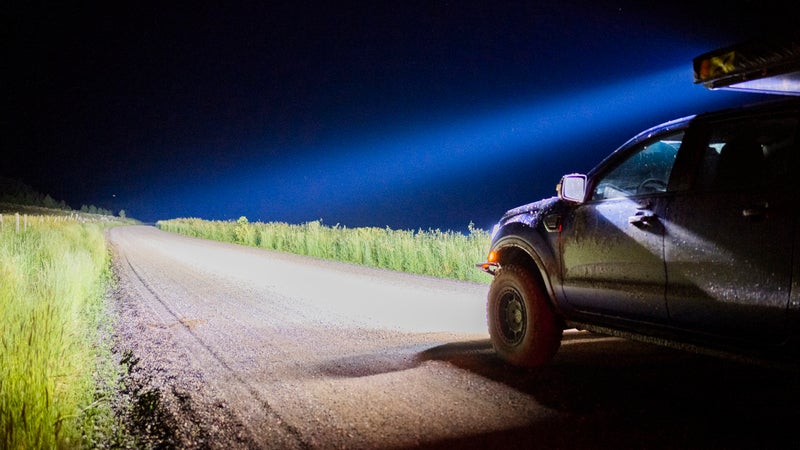
My 2019 Ford Ranger is our adventure vehicle. Its build prioritizes practicality off-road and in camp╠řat the expense of convenience around town╠řand refinement on long highway drives. Still, itÔÇÖs seen╠řthe most use, carrying us and our dogs to southern Baja, Mexico, for our wedding, taking us on daily hikes, and getting us to╠řweekend adventures around southwest Montana. It also supports my hunting, which, as you know if you participate in that sport, takes place in the absolute worst weather possible.
The biggest risk╠řto drivers down in Baja is╠řall the livestock that wanders around the roads at night. There are no streetlamps on the peninsulaÔÇÖs rural roads, and cows, horses, and other animals roam freely across them. Up here in Montana, we have everything from elk to moose to grizzlies on the roads, too. So╠řI wanted this truck to have a lot of light╠řand be able to respond to varying weather conditions with different kinds of light.
I initially tried to do that with one of the well-regarded American driving-light brands, which is when I learned that raw lumens donÔÇÖt necessarily translate to real-world light performance. Frustrated, I looked for a better solution, and thatÔÇÖs when I discovered Lightforce. Little known in this country, the Australian brand manufacturers all its products in Australia╠řand submits every one of its lights to an independent body for performance testing. Lightforce╠řtakes special care to ensure its driving lights operate at 5,000 kelvin, which should be considered an ideal color temperature. It’s warm enough to see through dust and precipitation, yet accurately renders colors, and is relaxing to look at.
With the Ranger, I wanted to achieve floodlighting across the road in front of me and╠řlong-distance performance for higher speeds in places like Baja or remote parts of Montana. I also wanted╠řshort-distance amber fog lights for driving in heavy snow or fog and practical work lights for╠řthe GoFastCampers Platform╠řthat rides╠řin the truckÔÇÖs bed. I achieved all of that by mounting a 30-inch single-row Lightforce bar in╠řthe front bumper, a 40-inch two-row bar on the roof, and some affordable new camper lights from ╠řon the GoFastCampers Platform. IÔÇÖve╠řstruggled to find fog lights capable of producing enough power to make them worthwhile,╠řbut I just received ╠řand plan to wire those up later this month. Fingers crossed.
╠řis capable of achieving one lux at 1970 feet, but I have it angled downward╠řenough that it cuts off at about 1,000 feet╠ř. This arrangement creates a very bright flood pattern in front of the truck, out to a╠řdistance thatÔÇÖs ideal for navigating slippery surfaces off-road╠řor in winter conditions. Pointed at the horizon, provides one lux of illumination at 2,800 feet. The LEDs in both bars are arranged in a combination pattern, pivoting from pointing very far outward╠řat the sides╠řto straight ahead in the middle. With both switched on, that effectively means IÔÇÖm turning a semicircle with a radius of half a mile into daylight. That capability is empowering, giving me the most information possible with which to navigate complicated trail junctions╠řor pick the best lines over or around challenging obstacles. At 65 mph, these lights give me 29 seconds of reaction time.
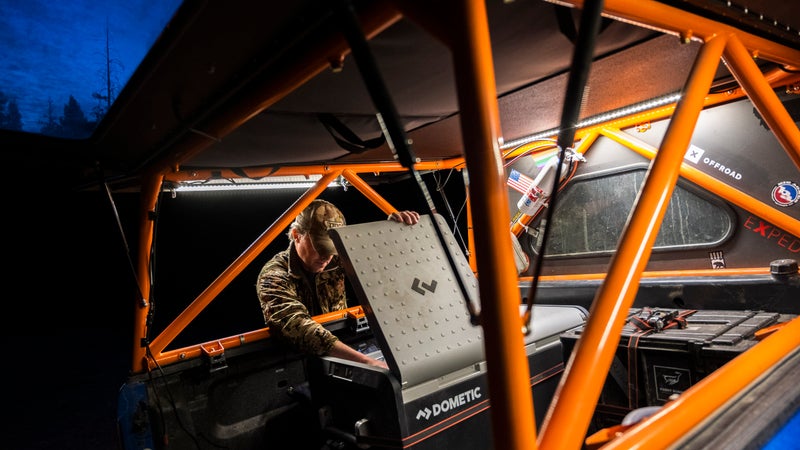
The TruckParts.Parts work lights in the camper run off the battery connected to my solar panels╠řand are wired to a switch just inside the tailgate. Inexpensively manufactured, IÔÇÖd hesitate to quote any performance figures for them, but theyÔÇÖre bright enough to illuminate the entire bed of the truck, and because the side lights mount inside the GoFastCamperÔÇÖs lift panels, theyÔÇÖll light up a reasonably large campsite, too. They switch from white to red (which attracts fewer bugs)╠řand are capable of dimming.
But bolting ungainly light bars and light pods all over the front of a truck isnÔÇÖt exactly an aerodynamic╠řor visually appealing solution. So╠řfor my wifeÔÇÖs Land Cruiser, which IÔÇÖm in the process of building into a peerlessly capable luxury travel vehicle, I wanted to find a sleeker alternative that didnÔÇÖt sacrifice performance. I ended up finding something that provides substantially more light than whatÔÇÖs fitted to the Ranger, all in an elegant pair of driving lights that perfectly compliment the ToyotaÔÇÖs styling.
By wrapping the perimeter of a large HID reflector with a ring of 20 LEDs, Lightforce has created not only one of the most powerful driving lights ever made╠řbut also one of the most versatile. Together, a pair of HTX2ÔÇÖs provides one lux of light at 1.1 miles, with a beam thatÔÇÖs 122 yards wide. The HID and LED components switch separately, so you can run eitherÔÇöor bothÔÇödepending on your needs. And that makes this a true two-light solution, not just for any driving-light needs╠řbut for lights which outperform anything else out there.
Key to that performance is how well integrated and complimentary the light provided by both elements is. The color temperature of the light produced by both the HID and LED╠řis perfectly matched (both are 5,000 kelvin), and the meticulous design of the individual reflectors has resulted in no shadows, artifacts, or perimeters visible within the projected light.
YouÔÇÖll notice that, right from the beginning of the article, IÔÇÖve talked about seeing through the dark, rather than just illuminating it. Switch on╠řmost powerful LED driving lights, and youÔÇÖll be overwhelmedÔÇönot by how much light they produce╠řbut by the glare and reflections created by that light. Not so on the HTX2ÔÇÖs. The perimeter╠řLEDs alone provide substantially more illumination than the AR-21ÔÇÖs on the 4Runner. Add the HIDs, and itÔÇÖs like a tunnel has been╠řbored in the night in front of you. ThereÔÇÖs no glare, and reflections only become an issue with close-distance road signs.╠řThe difference between these things and other driving lights is like the difference between cheap and expensive binoculars.
Why does anyone need such powerful lights? Here in Montana, where the population density is six people per square mile, the nighttime speed limit on rural and dirt roads just so happens to be 65 mph. At that speed, the Lightforce HTX2ÔÇÖs give my wife 61 seconds with which to spot something dangerous, make a plan to avoid it, then execute that plan. We use these things because they provide╠řthe most safety possible. They╠řreally do enable us to see through the dark.


